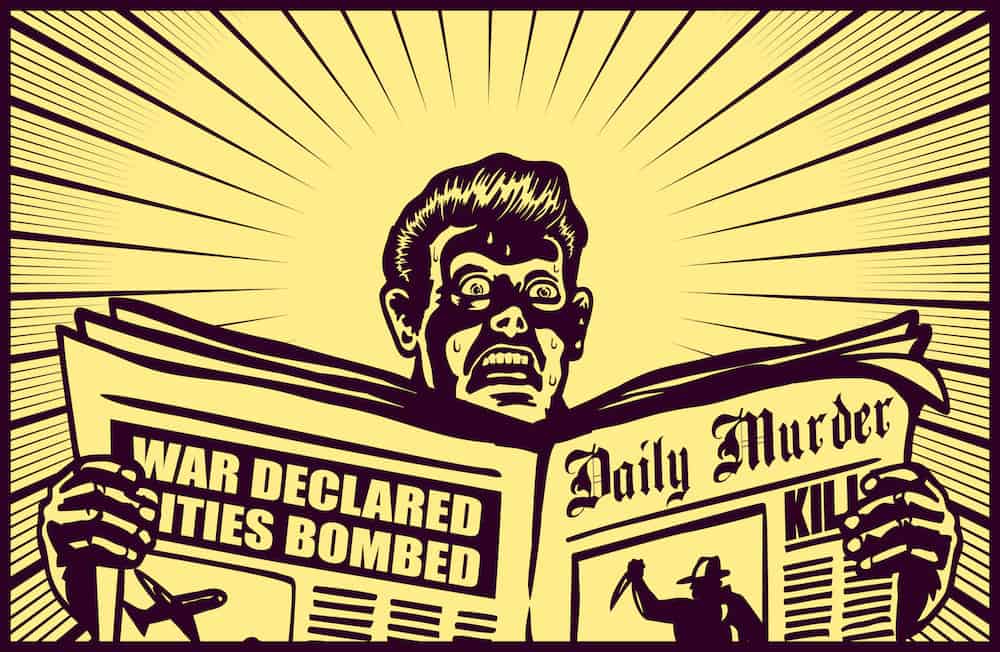Podcast Version
- Stranger: What do you do?
- Internet Marketer: Nothing
- Stranger: How do you pay for stuff?
- Internet Marketer: Money just shows up every month in Paypal and checks come to the door.
- Stranger: Who sends you the money?
- Internet Marketer: The internet.
- Stranger: Goes to Google and types in “how to make money on the internet?”
The IM world welcomes another member.
Fatstacks annoys some people. Yeah, I know it’s weird, but true. You should read some of the emails and comments I get.
Bless their hearts though. They take the time to tell me I’m a jerk or that I mislead people or worse.
I don’t blame them.
Too much comes across around here as if my online publishing business is all sunshine, bubblegum and lollipops.
It’s not. Never has been. Never will be.
I’ve scraped, clawed and climbed hurdles for over 10 years to get to this point. While I’ve had some lucky breaks along the way, it’s been a lot of work and I’ve suffered more failures than success.
Coleman Cox said something to the effect “the harder I work, the luckier I get.” There’s some truth in that (although I don’t subscribe to the suggestion that just because you work hard, you’ll succeed).
After I published the article “How I grew my blogging business $0 to 7 figures in 10 years” many people emailed me saying they really appreciated my recounting of my bigger failures along the way.
Given failures seem to inspire and resonate, I decided to dedicate an entire article setting out all of my bigger site failures in detail.
Below I get to play armchair quarterback on my own business and do my best to explain why certain sites I’ve launched and put time/money into over the years failed.
Let’s start at the very beginning because I failed out of the gates. Yup, my first site, which I poured endless hours into plus money I scarcely had, failed. It never earned a cent. I was clueless. BUT, I learned a lot.
Here they are in chronological order.
Failure #1: My first Niche blog
Actually, my first blog was a blog for my brick and mortar business which was a huge success, but that’s a different thing altogether. My first niche blog not tied to any brick and mortar business failed spectacularly.
I launched it on Site Build It. WordPress was around but I fell for the Site Build It pitch. Ultimately I moved this blog to WordPress, but even that didn’t save it.
I wrote about 70 articles in my spare time for this site before throwing in the towel. It was many months. Boy, was I optimistic. I gained a bit of traffic but never earned a dime.
Why did it not earn?
First of all, I didn’t use display ads back then. I only knew affiliate marketing and that’s what I tried. I didn’t understand the importance of buyer intent when it comes to affiliate sites.
Failure #2: Three Hyper-Focused Niche Sites
I learned from the first failure that to make affiliate marketing work, the site needed to align with buyer intent for specific products. “Okay” I thought to myself. I publish hyper-focused niche sites that plug one product.
Because I worked as a lawyer, I launched law-related sites. These three niche sites were hyper-focused and created to promote one specific law product. One made some money. Two made nothing. I put quite a bit of time into these sites.
In the long run, they never took off. The content was actually decent because it was law-related and I’m a lawyer. I wrote it all myself.
Why did they fail?
One of them failed because the product was junk. It was a legal insurance product.
Another failed because the keyword research was bad.
The third actually made money, but it was so hyper-focused it didn’t have any real traffic potential.
Failure #3: Two high-earning sites lost all their traffic
It’s debatable whether these were failures because for a couple of years they made good money ($4K to $6K per month each). That was until the Mighty G unleashed the first Penguin update into the algo.
The search carnage was unlike anything to date for many site owners. Small biz owners, large company sites and niche bloggers lost staggering amounts of traffic.
I was a casualty. Once I realized what Penguin targeted, I knew my sites were properly torpedoed. I had built lousy links by the thousands because it worked.
On the one hand those sites were a success because they did do well, but on the other they didn’t stand the test of time.
Easy come; easy go.
Failure #4: Database site (deindexed – OUCH)
This was a long tail keyword play at scale. It was my introduction to the power of long tail keywords. This time around I executed it terribly.
I launched a site and 200+ pages all at once with only titles. I scrambled to add content, which was all pretty much the same targeting related long tail keywords.
After a couple of months because it was pretty much all duplicate content, it was deindexed.
I chalk it up to a good idea with respect to going for long tail, but horribly executed. Another misguided shortcut.
Failure #5: Local sites for rent
This was a shortlived effort. After Penguin there was a new gig in town. Actually this gig had been around for some time but it grew in popularity.
The strategy was simple. Launch and rank local sites for a specific industry and then rent it out to a relevant local business.
As usual, I didn’t take baby steps. I launched 15 at one time. It was a ton of work.
Mid-way through the effort, I discovered the waves of free traffic Facebook was pouring onto sites and shifted gears. It was a smart move. I launched a site in a clickbait friendly niche and built a sizeable email list with free and paid traffic from Facebook.
It was profitable quickly.
I leveraged that knowledge into my current site #1 and milked Facebook until it was dry.
Whether the local rental sites would ever have worked is anyone’s guess. I suspect many people made it work, and while I always liked local search (from my brick and mortar days), the speed and ease of Facebook was a better strategy.
Failure #6: Facebook clickbait traffic site
Actually, this was a partial success. It’s the first site mentioned in Failure #5 above. However, I took shortcuts. I managed to get loads of traffic from FB, but the content on the site was bad. It was short content that linked to other sites. I monetized with display ads and building an email list.
It worked for a while until I struggled to scale it.
That’s when I shifted gears and launched what is now my biggest niche site. Again, that quasi-failure taught me plenty.
Failure #7: 25+ sites that went nowhere
Along the way, I’ve probably launched at least 25 sites that went nowhere as a result of indifference or bad ideas from inception.
They’re forgettable except for the domains I paid for which sat in my Bluehost account until I turned off auto-renew en masse a few years ago. Combing through all those domains reminded me of all the stuff I’ve thrown against the wall over the years.
Failure #8: 100 site PBN
This was costly and a massive waste of time. It was also bad timing. Had I done this 6 years ago, I’d probably made a fortune but instead I was late to the party and actually did this a short couple years ago.
PBN stands for “private blog network” all of which are used to build links to money sites. I had resisted the urge of building them for years. It’s an organizational headache but if pulled off very well, can help sites rank quickly.
I had launched what is currently site #4. The potential traffic for that niche is really high so my brilliant idea was to pour gasoline on it in the form of 100+ PBN links.
I paid many services to build them out. I paid several other services to write mediocre content.
Once built out it was time to deploy them but I simply didn’t have the nerve. Site #4 was starting to gain traffic. The content on that site is quite good. I knew (and know) it has huge potential. I simply didn’t want to risk pickling the domain because once a site is pickled, it’s almost impossible to de-pickle it.
That 100+ site PBN probably cost me $10,000. In the long run, I suspect I’ll be better off not using it, but one never knows.
I also learned that building PBNs is one of the most frustrating pursuits online. Kudos to anyone who builds them successfully.
Failure #9: Affiliate store (cost me $13,000)
I shake my head about this costly mistake.
Somehow I thought it would be a good idea to create a massive affiliate store on a subdomain of one of my niche sites. The content consisted of 150 to 500 word write ups for various products with an affiliate link to a merchant to purchase the product.
I outsourced hundreds of product descriptions in one fell swoop. I should have started with 50, but no, I had to go all in.
Needless to say that short product descriptions with affiliate links don’t and certainly don’t bank.
And that’s not every mistake (by any stretch)
The above list are my more notable mistakes, most of which were costly. I’ve made many more mistakes along the way including on my current niche sites.
I get tired just thinking about all the crap I tried and failed at over the years. I put a lot of work into every failure above. Some cost a ton of money too (the PBN failure was horrendously expensive).
However, because I tried so many things, I managed to launch a few gems along the way which now forms my business.
Contrast all these failures with my successes
After the above road of carnage, I’m currently left with 5 sites that earn more than four figures plus per month. That’s it. Granted one niche site earns over $40K per month which makes up for a lot. That success is the foundation for Fatstacks which does very well.
While I’ve had a good number of sites that earned okay money at some point many ultimately failed along the way. After the dust has settled, I have 5 successful niche sites.
The good news is it only takes one site to establish a successful online business. Just one.
Morals of the story:
- Failure is inevitable.
- This biz takes time to grow.
- You do learn things from failure.
- Shortcuts usually don’t pay off.
- Affiliate marketing requires audience alignment AND/OR buyer intent.
- It only takes ONE SITE to earn a fortune and make up for all the failures.
- The lowly display ad can make you rich.

Jon Dykstra is a six figure niche site creator with 10+ years of experience. His willingness to openly share his wins and losses in the email newsletter he publishes has made him a go-to source of guidance and motivation for many. His popular “Niche site profits” course has helped thousands follow his footsteps in creating simple niche sites that earn big.









